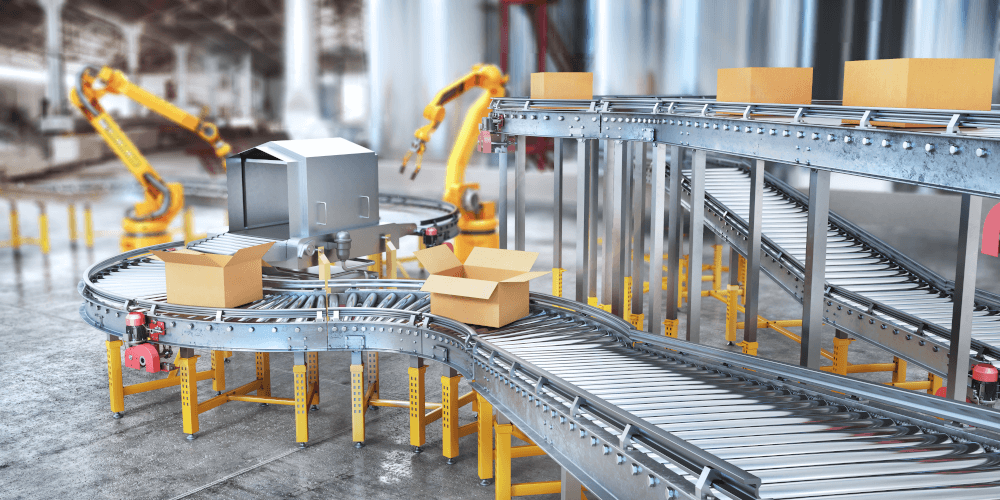
By Joanne Moss
SE Automation knows Automation and Controls. And after working with hundreds of customers in the Material Handling industry, we know how to apply them to save time, money, and space on your plant floor – all while increasing efficiency. By integrating advanced technologies, businesses are streamlining operations, cutting costs, and making workplaces safer. Let’s dive into how automation and controls are shaking things up in material handling, the benefits they bring, and the cool tech driving these changes.
The Role of Automation in Material Handling
Automation in material handling uses advanced tech to make moving, storing, and managing materials smoother and more efficient. Here are some key systems making a difference:
- Automated Guided Vehicles (AGVs): These self-driving vehicles use sensors, cameras, and software to navigate and transport materials around facilities, cutting down on the need for human help and boosting efficiency.
- Automated Storage and Retrieval Systems (ASRS): ASRS use cranes, shuttles, or robots to store and retrieve items in warehouses. These systems maximize space and improve inventory management.
- Conveyor Systems: Using belts, rollers, or chains, these systems transport materials efficiently and are a staple in industries that need to move large volumes quickly.
- Robotic Arms and Manipulators: These programmable machines handle tasks like picking, placing, assembling, and packaging with precision, especially when dealing with delicate or hazardous materials.
- Sortation Systems: These systems automatically sort and route items based on size, weight, or destination, making them perfect for busy distribution centers and e-commerce hubs.
Advanced Control Systems for Enhanced Efficiency
Control systems are the brains behind the operations of automated equipment in material handling. These include:
- Programmable Logic Controllers (PLCs): Reliable industrial computers that control machinery and processes.
- Supervisory Control and Data Acquisition (SCADA) Systems: These provide real-time monitoring and control, helping optimize operations with data from various sensors.
- Human-Machine Interfaces (HMIs): These interfaces allow operators to interact with automated systems, giving a clear visual overview of processes and equipment status.
Five Big Benefits of Automation in Material Handling
- Boosts Output and Cuts Processing Time: Automation lets warehouses handle large volumes faster, cutting down processing time while increasing output. This means better order fulfillment and lower costs.
- Makes Work Safer: Automated systems take over tough, dull, dirty, or dangerous tasks, reducing the risk of injuries and making work less stressful. This boosts productivity and reduces errors.
- Improves Quality Control: Automation helps spot products that don’t meet quality standards before they’re shipped. Real-time data and analytics on defects help continuously improve quality and reduce the risk of recalls.
- Cuts Labor Costs and Needs: With labor shortages being a big challenge, automation steps in to perform tasks traditionally done by workers, like picking or driving forklifts. This reduces labor costs and allows employees to focus on more complex tasks.
- Makes Better Use of Space: Automation allows for better use of vertical space, stacking materials higher and more densely. This frees up floor space, enabling expansion without needing more square footage.
Cool New Technologies and Innovations
As industries go digital, material handling automation is evolving with some amazing new technologies:
- Robotics: Including collaborative robots (cobots), adaptive grippers, and robotic vision systems that enhance precision, speed, and flexibility.
- Artificial Intelligence (AI) and Machine Learning (ML): These enable predictive analytics, intelligent routing, computer vision, and predictive maintenance, optimizing system performance and decision-making.
- Internet of Things (IoT) and Sensors: These techs help with real-time monitoring, data collection and analysis, and wireless communication, making systems more connected and smarter.
Staying Safe and Compliant
Safety and compliance are crucial when it comes to material handling automation. Important standards and regulations include:
- ISO 13849-1: Sets safety requirements for control systems’ design and integration.
- ANSI/RIA R15.06: Covers safety requirements for industrial robots and robot systems.
- OSHA Regulations: Provides guidelines for the safe operation of material handling equipment and workplace safety.
To maintain safety, it’s important to conduct risk assessments, integrate safety features into designs, ensure clear communication and signage, perform regular maintenance, and train operators thoroughly.
Wrapping It Up
Automation and controls are game-changers for the material handling industry, offering greater efficiency, lower costs, and safer workplaces. As technology advances, innovations in robotics, AI, IoT, and sensors will continue to optimize these processes. Understanding the basics, key components, and best practices of material handling automation is key to successfully designing, implementing, and operating these systems. By embracing these technologies, businesses can stay competitive in a rapidly evolving market.
References:
Wevolver. (2023, April, 21) Material Handling Automation: A Comprehensive Guide for Engineers. Robotics. www.wevolver.com/article/material-handling-automation
Beldon. (2023, July, 11) Material Handling Automation: 5 Reasons Why It’s So Important. Beldon Blogs. www.belden.com/blogs/industrial-automation/2023/07/11/automation-in-material-handling-5-reasons-why-its-so-important
